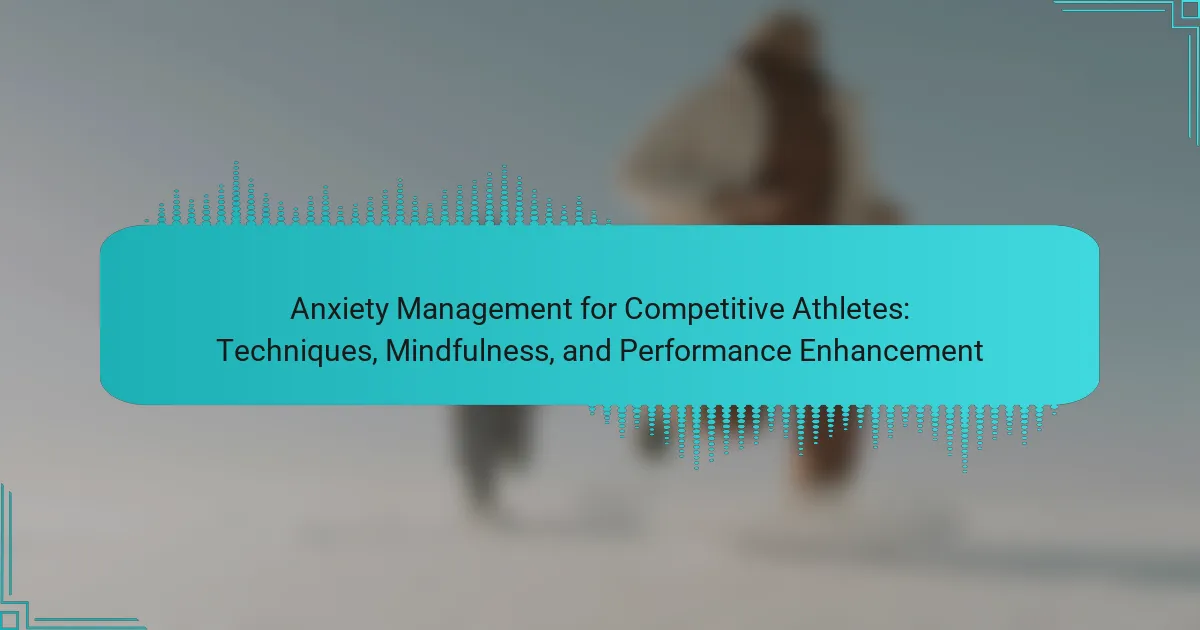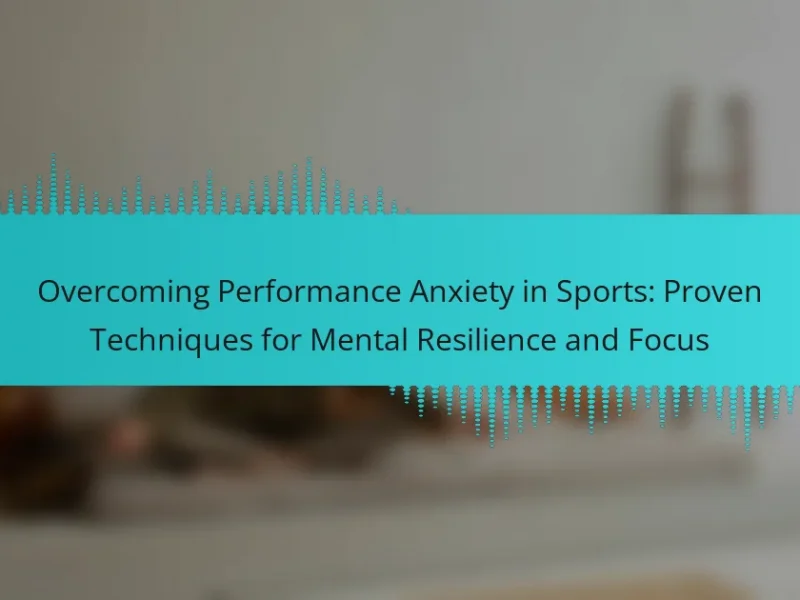Managing anxiety is crucial for competitive athletes to enhance focus and performance. This article explores effective techniques such as mindfulness practices, cognitive-behavioral strategies, and breathing exercises. It also examines innovative approaches like biofeedback and virtual reality exposure therapy. Implementing these methods can lead to improved emotional regulation and resilience in high-pressure situations.

How does anxiety impact competitive athletes?
Anxiety negatively impacts competitive athletes by impairing focus, reducing performance, and increasing fatigue. Techniques for managing anxiety include mindfulness practices, cognitive-behavioral strategies, and breathing exercises. These methods enhance performance by promoting mental clarity and emotional regulation. Research shows that athletes who employ these techniques report improved outcomes in high-pressure situations.
What are the common symptoms of anxiety in sports?
Common symptoms of anxiety in sports include excessive worry, restlessness, difficulty concentrating, muscle tension, and sleep disturbances. These manifestations can hinder performance and mental clarity during competitions. Athletes may experience physical symptoms like increased heart rate, sweating, and gastrointestinal issues. Recognising these symptoms is crucial for effective anxiety management strategies.
How does performance anxiety differ from general anxiety?
Performance anxiety is a specific type of anxiety that occurs in high-pressure situations, whereas general anxiety encompasses broader, persistent feelings of worry. Performance anxiety is often linked to fears of failure or negative evaluation during competitions, while general anxiety can manifest in various daily life scenarios. Athletes may experience performance anxiety as a unique attribute that impacts their focus and execution, leading to decreased performance. In contrast, general anxiety may affect overall well-being but does not necessarily relate to specific performance contexts. Understanding these differences is crucial for effective anxiety management strategies in competitive sports.

What universal techniques can athletes use to manage anxiety?
Athletes can use techniques like deep breathing, visualization, and mindfulness to manage anxiety effectively. These strategies enhance focus and performance under pressure. Deep breathing exercises promote relaxation by slowing heart rate and calming the mind. Visualization techniques involve imagining successful performance, which can boost confidence. Mindfulness practices help athletes stay present, reducing negative thoughts about outcomes. Regular practice of these techniques can lead to improved emotional regulation and resilience in competitive situations.
What role does physical conditioning play in anxiety management?
Physical conditioning significantly reduces anxiety levels in competitive athletes. Regular exercise enhances physical health, boosts mood, and improves sleep, all of which contribute to lower anxiety. Research shows that aerobic activities, such as running or swimming, can decrease symptoms of anxiety by releasing endorphins, promoting a sense of well-being. Additionally, strength training has been linked to improved mental resilience, fostering a unique attribute of enhanced coping mechanisms during stressful competition. Engaging in structured conditioning routines also instills discipline and focus, further aiding in anxiety management.
How can breathing exercises help reduce anxiety?
Breathing exercises can significantly reduce anxiety by promoting relaxation and enhancing focus. These techniques help athletes manage stress, improve performance, and maintain mental clarity during competitions. Studies show that controlled breathing lowers cortisol levels, which are linked to anxiety. Additionally, deep breathing increases oxygen flow, improving overall physical and mental well-being. Regular practice can lead to a unique attribute of resilience, allowing athletes to handle pressure more effectively.
What are the benefits of visualization techniques for athletes?
Visualization techniques significantly enhance performance for athletes by improving focus, reducing anxiety, and boosting confidence. These techniques allow athletes to mentally rehearse their performances, which can lead to better execution during competition. Research indicates that visualization can decrease pre-competition anxiety by promoting a sense of control and preparedness. Additionally, athletes who regularly practice visualization report increased self-efficacy and motivation, contributing to overall performance enhancement.
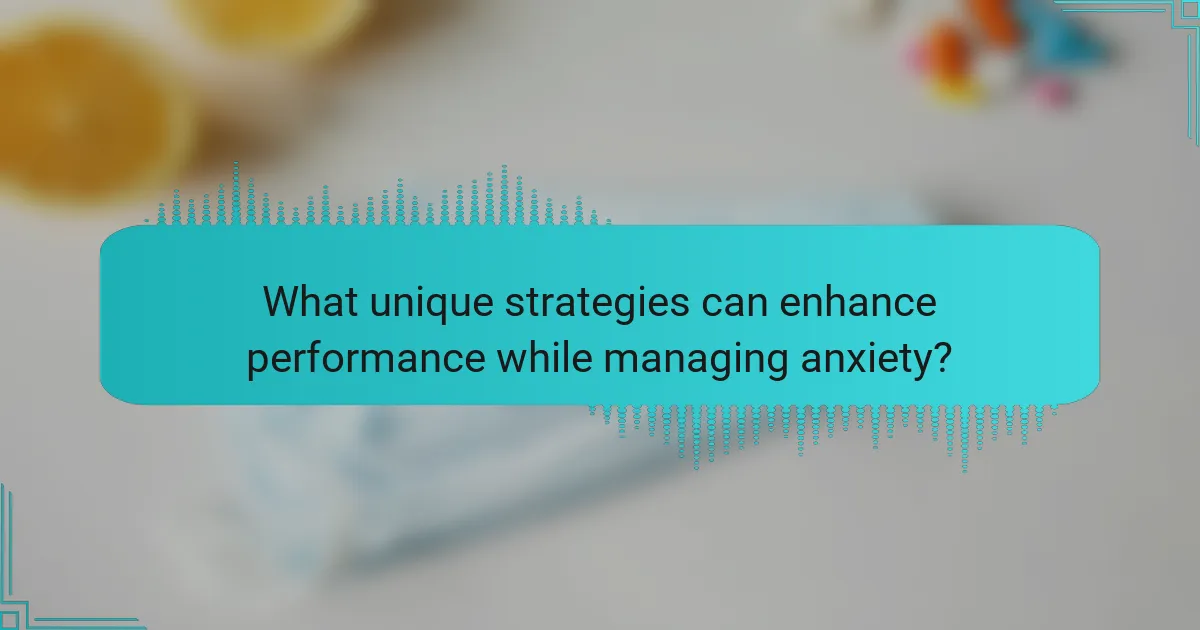
What unique strategies can enhance performance while managing anxiety?
Mindfulness techniques can significantly enhance performance while managing anxiety in competitive athletes. Strategies such as deep breathing, visualization, and focused attention help athletes maintain composure under pressure. Practicing mindfulness regularly fosters resilience and improves concentration, leading to better performance outcomes. Incorporating these techniques into training routines can create a unique advantage in high-stress environments.
How does cognitive-behavioral therapy apply to athletes?
Cognitive-behavioral therapy (CBT) effectively helps athletes manage anxiety by reshaping negative thoughts and behaviors. Techniques include cognitive restructuring, which identifies and alters unhelpful beliefs, and exposure therapy, gradually facing fears to reduce anxiety. Mindfulness practices enhance focus and emotional regulation, improving performance under pressure. Research shows CBT can significantly lower anxiety levels in competitive athletes, leading to better outcomes in competitions.
What is the impact of team dynamics on anxiety levels?
Team dynamics significantly influence anxiety levels in competitive athletes. Positive interactions foster support, reducing stress, while negative dynamics can increase anxiety. Research shows that cohesive teams enhance individual performance and mental well-being. Effective communication and trust among team members are critical root attributes for managing anxiety. Furthermore, athletes reporting strong team bonds experience lower anxiety, leading to improved focus and performance.
How can communication improve team support for anxious athletes?
Effective communication enhances team support for anxious athletes by fostering understanding and trust. Open dialogue allows athletes to express their feelings, reducing isolation. Regular check-ins and feedback create a supportive environment, enabling athletes to share their challenges. Incorporating mindfulness techniques into team discussions can also help athletes manage anxiety effectively. This approach cultivates a culture of empathy, ultimately improving performance and mental well-being.

What rare approaches are available for anxiety management in sports?
Innovative approaches for anxiety management in sports include biofeedback, art therapy, and virtual reality exposure therapy. These techniques enhance mental resilience and performance. Biofeedback allows athletes to gain real-time insights into physiological responses, promoting self-regulation. Art therapy fosters emotional expression, reducing anxiety through creativity. Virtual reality exposure therapy simulates competitive environments, helping athletes acclimate to stressors. Each method offers unique benefits that can complement traditional strategies, providing rare alternatives for managing anxiety effectively.
How can biofeedback techniques assist in anxiety reduction?
Biofeedback techniques can significantly assist in anxiety reduction for competitive athletes. These methods enhance self-awareness and control over physiological functions, leading to improved mental performance.
By using biofeedback, athletes learn to recognize stress responses and manage anxiety symptoms effectively. For example, heart rate variability training helps athletes regulate their heart rates, promoting relaxation.
Research indicates that athletes who incorporate biofeedback techniques report lower anxiety levels and improved focus during competitions. This unique attribute of biofeedback makes it a valuable tool for enhancing performance under pressure.
Overall, biofeedback empowers athletes to transform anxiety into a manageable state, fostering a competitive edge.
What are the potential benefits of adopting a growth mindset?
Adopting a growth mindset can significantly enhance anxiety management for competitive athletes. This mindset fosters resilience, encourages adaptive coping strategies, and promotes a focus on personal development. Athletes with a growth mindset view challenges as opportunities for growth, which can reduce performance anxiety. Research indicates that such athletes experience improved concentration and increased motivation, leading to better performance outcomes. Emphasising effort over fixed abilities allows athletes to embrace setbacks as learning experiences, further enhancing their mental fortitude.
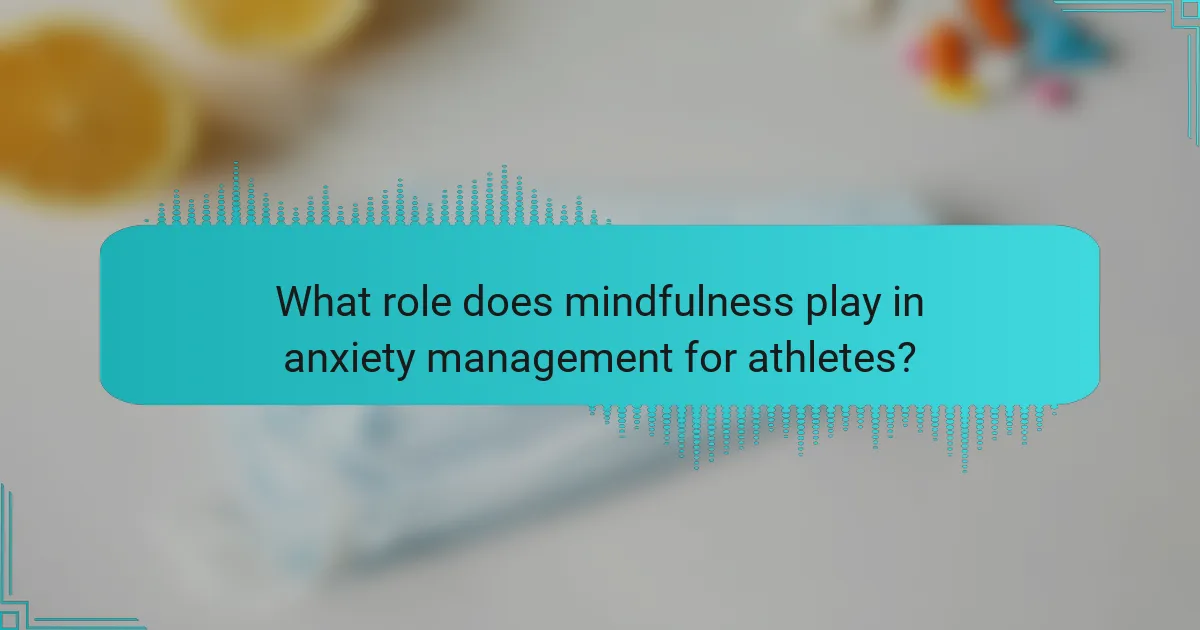
What role does mindfulness play in anxiety management for athletes?
Mindfulness significantly aids in anxiety management for athletes by promoting mental clarity and emotional regulation. Techniques such as focused breathing and visualization help athletes stay present, reducing performance-related stress. Research indicates that mindfulness practices can lower anxiety levels and enhance focus, leading to improved athletic performance. By integrating mindfulness into their training, athletes can develop resilience, enabling them to cope better with competitive pressures.
How can mindfulness practices improve focus during competition?
Mindfulness practices significantly enhance focus during competition by promoting present-moment awareness. Techniques such as deep breathing and visualization reduce anxiety, allowing athletes to concentrate better on performance. Research indicates that athletes who engage in mindfulness report improved focus and decreased distraction levels. Regular practice fosters a unique attribute of mental resilience, crucial for competitive success.
What specific mindfulness techniques are effective for athletes?
Breathing exercises, visualization, body scan, and mindful movement are effective mindfulness techniques for athletes. These methods help reduce anxiety, enhance focus, and improve overall performance.
Breathing exercises involve controlled inhalation and exhalation, promoting relaxation and lowering heart rate. Visualization techniques encourage athletes to mentally rehearse successful performances, boosting confidence. Body scans increase awareness of physical sensations, helping athletes identify areas of tension. Mindful movement incorporates techniques like yoga or tai chi, enhancing body awareness and reducing stress levels.
Implementing these techniques regularly can lead to significant improvements in competitive performance.
How can mindful meditation be integrated into training routines?
Mindful meditation can enhance training routines by improving focus and reducing anxiety. Incorporating mindfulness techniques, such as breath awareness and body scans, helps athletes stay present during workouts. Regular practice can lead to better emotional regulation, which is crucial in high-pressure competitive environments. Athletes who integrate mindfulness report increased performance and resilience, making it a valuable tool for anxiety management.
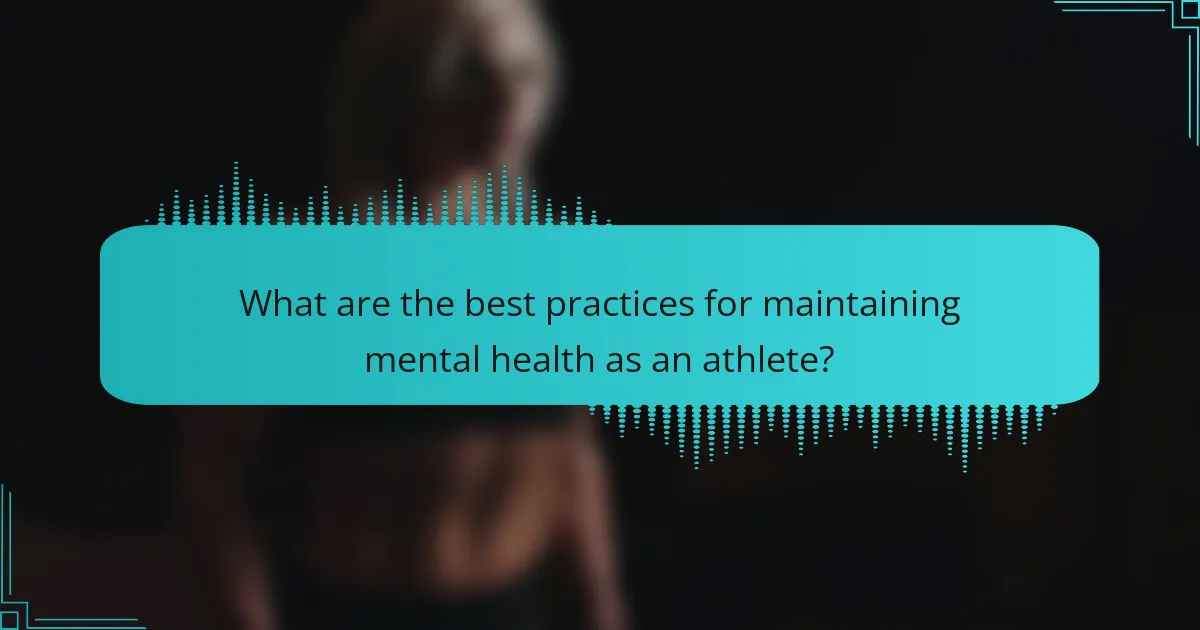
What are the best practices for maintaining mental health as an athlete?
To maintain mental health, athletes should practice anxiety management techniques, mindfulness, and performance enhancement strategies. Techniques such as deep breathing, visualization, and cognitive restructuring can effectively reduce anxiety levels. Mindfulness practices, including meditation and focused attention, help athletes stay present and improve overall mental resilience. Additionally, setting realistic performance goals and engaging in regular physical activity can enhance mental well-being, leading to better athletic performance.
How can athletes create a supportive network for mental health?
Athletes can create a supportive network for mental health by prioritising open communication and fostering connections. This includes establishing relationships with coaches, teammates, and mental health professionals. Engaging in group activities promotes camaraderie and reduces feelings of isolation. Regular check-ins can enhance emotional support and accountability. Additionally, sharing experiences and strategies for anxiety management can strengthen bonds and improve overall well-being.
What common mistakes should athletes avoid in anxiety management?
Athletes should avoid common mistakes like neglecting self-awareness, over-relying on techniques, and ignoring rest. These pitfalls can hinder effective anxiety management. Failing to recognise personal triggers limits progress. Over-reliance on techniques may lead to performance anxiety. Lastly, neglecting adequate rest diminishes mental resilience.
What expert insights can enhance anxiety management strategies?
Expert insights can significantly enhance anxiety management strategies for competitive athletes through targeted techniques and mindfulness practices. Integrating cognitive behavioural approaches can help athletes identify and reframe negative thoughts, fostering a positive mindset. Mindfulness training, including meditation and breathing exercises, promotes emotional regulation and focus, essential for optimal performance. Additionally, visualization techniques allow athletes to mentally rehearse successful outcomes, reducing anxiety and enhancing confidence. Regular feedback from coaches and sports psychologists can provide personalised strategies, ensuring athletes remain mentally resilient in high-pressure situations.
How can journaling contribute to better mental health for athletes?
Journaling significantly enhances mental health for athletes by providing a structured outlet for emotions. It helps athletes process anxiety, fostering mindfulness and focus. Studies show that regular journaling can reduce stress levels and improve performance by promoting self-reflection and emotional regulation. By documenting thoughts and feelings, athletes can identify triggers and develop coping strategies, ultimately enhancing their mental resilience.
